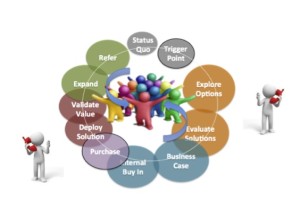by Mike Connor, Principal, Spice Catalyst
The customer journey provides a powerful customer-focused framework for defining not only customer needs but also sales enablement requirements.
 The world of business-to-business marketing has put a tremendous emphasis on content marketing over the last years. Despite that focus, the bar for sales has never been higher. Research says more than 60% of the purchase decision is made before customers ever engage a salesperson. While that research makes a clear argument for creating great content, it also makes a powerful case for investing in world-class sales enablement.
The world of business-to-business marketing has put a tremendous emphasis on content marketing over the last years. Despite that focus, the bar for sales has never been higher. Research says more than 60% of the purchase decision is made before customers ever engage a salesperson. While that research makes a clear argument for creating great content, it also makes a powerful case for investing in world-class sales enablement.
In today’s market, no customer will be impressed by a salesperson who knows little about them, or that simply hands them literature they’ve already read. They’re going to demand sales people who come fully prepared to the first meeting. Prepared to take the customer’s knowledge to the next level, answer tough questions and become a full partner in moving their business and their purchase process forward.
The bottom line. B2B sales is personal. It takes great sales people who are well trained and exceptionally well supported to close deals. According to Steve Martin from the USC Marshall School of Business, “Today more than ever, it’s the personal interactions with prospective customers that determines winners from losers.”
To close those deals salespeople need information. The right information, at the right time in the purchase process, for the right person. There is no mystery here. Yet with all the marketing focus on content, there is plenty of research around that tells us most B2B salespeople spend as much as a day a week trying to find and restructure information to support their customers’ needs. That time lost by your sales team is time gained by competitors. In addition to lost sales effectiveness, it also translates into lost deals.
The customer journey provides a powerful customer-focused framework for defining not only customer needs but also sales enablement requirements. Used properly it can facilitate a detailed and highly effective planning dialogue between marketing and sales. One that accurately identifies the stage by stage needs of prospects and the sales team.
This blog series and supporting resources are dedicated to helping you create an Insanely Great Sales Enablement program. A program that increases marketing and sales effectiveness by aligning your investment in content with validated customer needs and by establishing an effective content architecture. One that reduces sales time lost chasing and restructuring content and puts you way ahead of the competition.
In a future post, I will discuss using the customer journey to define basic content requirements for customers and sales enablement.
